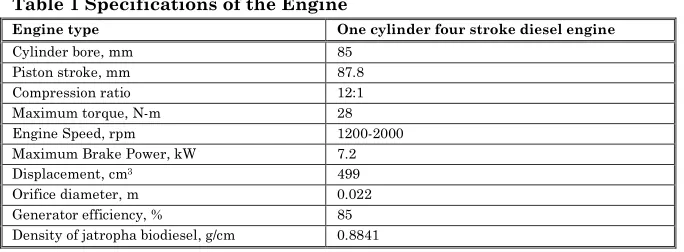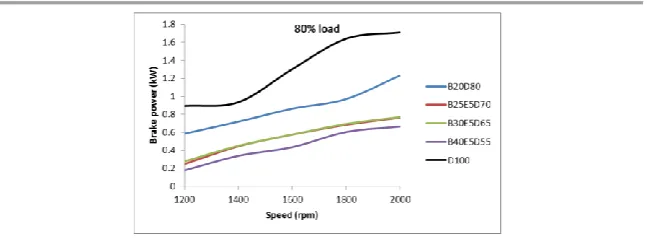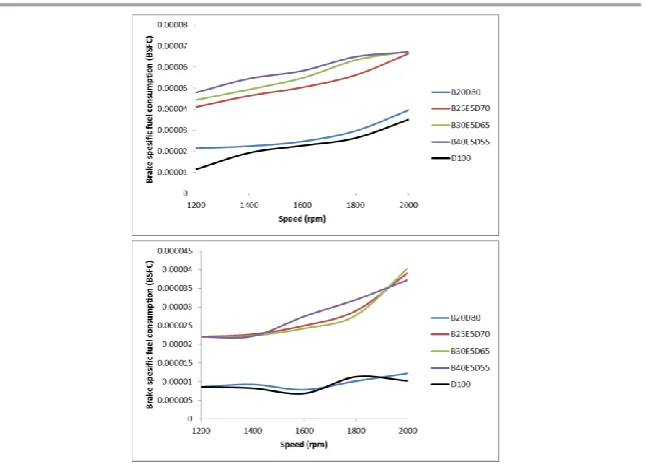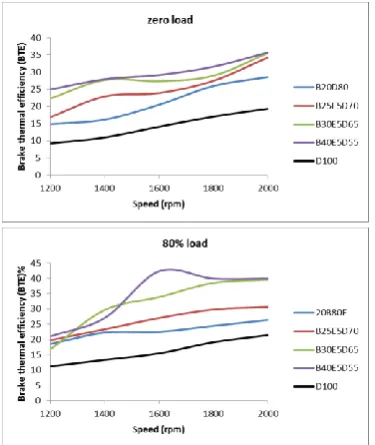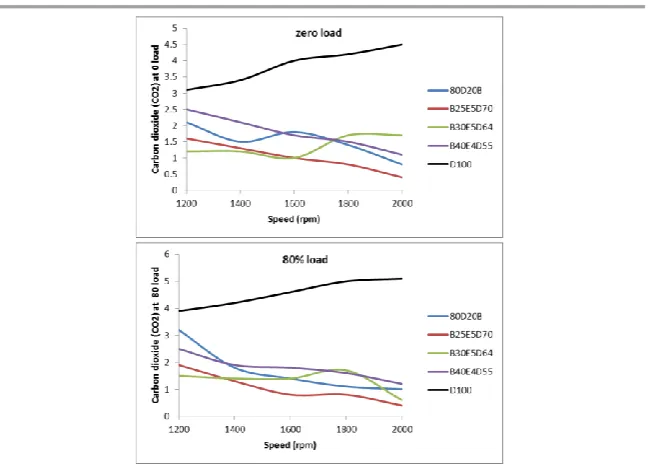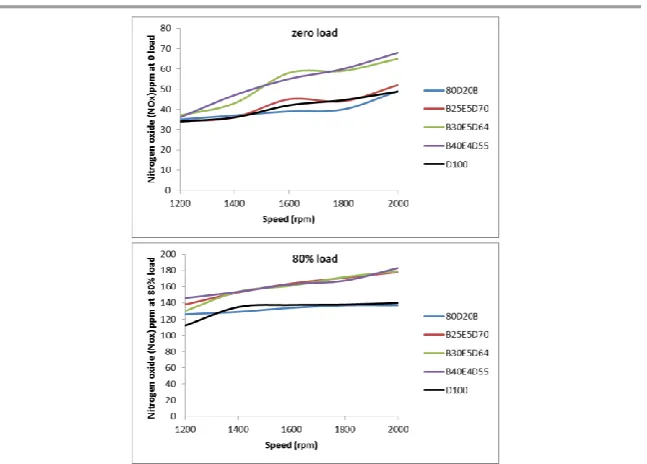ISSN 2286-4822
www.euacademic.org DRJI Value: 5.9 (B+)
Performance and emission characteristics of diesel
engine fueled by biodiesel and ethanol
FATIMA MOHAMMED GHANIM
Department of Mechanical Engineering College of Engineering, Kordofan University
ALI MOHAMMED HAMDAN ADAM
Department of Mechanical Engineering University of Bahri, Sudan
AWAB OSAMA ABDEL MAJID
Department of Mechanical Engineering College of Engineering, SUST, Sudan
Abstract:
A four strokes single cylinder directs injection water cooled, diesel engine was used to investigate the performance and emission characteristics of the engine when fueled by Diesel-Ethanol- Jatropha blend. The brake power , brake specific fuel consumption, brake thermal efficiency and concentration of exhaust gas emissions (carbon dioxide and nitrogen oxides) were conducted at speeds ranging from 1200 to -2000 rpm at zero and 80% load of the engine. A pure diesel and four blends (B20D80, B25E5D70, B30E5D65 and B40E5D55) were tested. The results showed that the brake power, brake specific fuel consumption, brake thermal efficiency and the nitrogen oxides increased with the rise of Jatropha-Ethanol percentage while the carbon monoxide decreased. This study recommends that further investigations of the blend ratios are required for the same engine by increasing ethanol percentage, which reduced the viscosity of the blend.
I - INTRODUCTION
The rapid depletion of oil reserves and environmental pollutions created an incentive to study and evaluate alternative fuels, which are renewable and cleaner than fossil fuels [1-3]. The biodiesel as an alternative renewable fuels which
can be used without or with a few modifications in diesel engines will be the most interesting and attractive in the future[4]. Biodiesel can be produced through transesterification
from a variety of vegetable oils including soybean, rapeseed, sunflower, peanut and palm [5, 6].
Sudan’s energy demand has significantly grown through the past 30 years from 6.8 million tons of oil equivalent (MTOE) to more than 11.2 MTOE [7]. Crude oil is the main source of
fossil energy and its consumption has rapidly increased in recent years owing to the increase in the country’s economic
and population growth[8, 9]. The amount of energy from biomass
has stayed relatively constant though its percentage contribution or share has significantly dropped due to high growth in hydro and crude oil-sourced fuels[10].
After the secession of southern Sudan, the sharp drop of the share in Sudan’s (North of the old Sudan) oil production (almost, 85 % of the old Sudan’s production) revitalized the interest in alternative fuels[11, 12]. Although, the production is
Due to the above mentioned factors, jatropha based biodiesel mixed with ethanol as a fuel for diesel engine was used in this research to analyze the engine performance and exhaust emissions by using a single cylinder four stroke diesel engine in order to attend better performance of the engine with little fuel consumption.
The main biofuels identified, or in production, in Sudan at the present are:
1- Ethanol
Sudan is considered one of the largest producers in Africa of
sugarcane and ethanol made from sugarcane molasses [15-18].
In 2009 Kenana Sugar Company (KSC), the Sudan's largest sugar producer launched an ethanol production plant based on 1st generation technology (molasses fermentation) with the capacity to produce commercial volumes of high-grade ethanol (65 million liters annually). While 90% of this ethanol is presently exported to EU, already some refueling stations in Sudan are selling an E10 blend (Nile-Ultra) and the test results for the pure ethanol are satisfactory[19]. Some trial work is being conducted into the relative advantages for producing fuel grade ethanol from sweet sorghum. One feature of the production of ethanol is that Sudan has the potential to use it as a fuel for agricultural spray planes.
2- Biodiesel
properties to those of petroleum diesel. Its flash point is higher than diesel oil and so it is safer to handle. Biodiesel also has a higher cetane number and diesel index. Biodiesel lower sulphur content and ash content make it more environmentally friendly than any fossil fuels[20, 21] .
One major constraint on production of biodiesel is the simple difficulty of getting a high yield of vegetable oils per hectare or acre (so resulting in very large land areas being needed). While that has generally turned out to be not so, with the development of strains with better genetics, and with optimal management on good sites jatropha is once again being seen as having the potential to produce the next highest yields (after the oil palm) of over 1.5 tons of oil per hr. Jatropha is again being considered as the plant with high potential to sustainably produce oil as a feedstock for production of biodiesel and bio jet fuel complying with standards specifications[22, 23].
II-MATERIALS AND METHODS
A) Materials
This section explains the experiments and the specifications of the devices and materials used in the experiments: diesel, jatropha biodiesel, ethanol (which are explained in the introduction above) and single cylinder four stroke diesel engines.
B) Engine specification
Table 1 Specifications of the Engine
C) Experiments
Experiments are conducted on four stroke single cylinder water cooled diesel engine at different speeds ranging from 1200 to 2000 rpm with interval of 200 rpm. Eddy current dynamometer is used to load the engine. Schematic representation of the experimental set up is as shown in figure1. The tests are conducted using four test fuel blends namely B20D80, B25E5D70, B30E5D65 and B40E5D55 as well as pure diesel fuel at zero and 80% load of the engine. Emission parameters
like carbon dioxide (CO2) and NOx are measured using exhaust
gas analyzer. The data pertaining to performance and emissions are recorded for these loads. Performance parameters like brake power, brake specific fuel consumption (BSFC),
brake thermal efficiency (BTE) and emissions like NOx and CO2
are analyzed and discussed.
Figure 1. The Equipment of the Experiment
Engine type One cylinder four stroke diesel engine
III- RESULTS AND DISCUSSION
The engine is run on four different test fuel blends as mentioned above. The performance and engine exhaust emission characteristics are analyzed and discussed.
1. Brake Power (BP)
Figure 2 shows the effect of engine speed variation on engine power. It is found that the engine power increases as the engine speed increases for all blends of biodiesel. The fuel D100 at zero loads at high speed (2000 rpm) gave high brake power of 0.57kW, when it compared to other fuel blends tested (B20D80, B25E5D70, B30E5D65 and B40E5D55) the engine power was shown to reduce by increasing the percentage of biodiesel in the blends. The main reason for power loss is due to the reduction in heating value and energy content of biodiesel compared to diesel[1]. Figure 2 showed that the D100 fuel at 2000 rpm at
Figure 2. Brake Power VS Engine Speed at 0% and 80% loads
2. Brake specific fuel consumption (BSFC)
Figure (3) shows the effects of biodiesel percentage at zero and 80% load on the brake specific fuel consumption. The Figure shows that at zero-load and 2000 rpm the blends B25E5 and B30E5 gave approximately the maximum brake specific fuel
consumption value, which is about 4.04e-5 (kg/kWh). The values
Figure 3. Influence of speed on BSFC at 0% and 80% Load
3. Brake thermal efficiency (ɳth)
load. This is due to the reduction in heat loss and increase in power developed with increase in load.
Figure 4. Influence of speed on BTE At 0% and 80% Load
4. Carbon dioxide (CO2)
The variation of CO2 emission with engine speed for diesel fuel
and Jatropha biodiesel blends and ethanol is presented in
Figure 5. It is found that the CO2 emission decreases with the
increase of biodiesel percentage in the blend for the entire range of engine speed for the zero and 80% loads. The same findings were obtained by other researchers. Significant drop in
CO2 emission profile when using B20D80, B25E5D70,
Figure 5 Influence of speed on CO2 At 0% and 80% Load
6. Nitrogen Oxides (NOX)
Nitric oxide (NO) and Nitrogen dioxide (NO2) are usually
Figure 6 Influence of speed on NOX at 0% and 80% load
IV. CONCLUSION
The objective of this study was to investigate the engine performance and emissions of a diesel engine operating on Biodiesel-ethanol blends and to compare them with pure diesel fuel.
Based on the experimental results, the following conclusions can be inferred:
The break power increases with the increasing of speed
and load and this due to increase in viscosity and reduction in heating value at the percentage of biodiesel and ethanol increases in the blends.
The BSFC for the biodiesel blends is higher than that of
diesel in the entire range of engine speeds examined. The brake specific fuel consumption of the engine fuelled by the blends was higher compared with pure diesel.
The brake thermal efficiency has the tendency to
The amount of CO2 and NOx emissions with engine
speed for diesel fuel and Jatropha biodiesel blends and
ethanol were varied, it was found that the CO2 emission
decreases with the increase of biodiesel percentage in the blend. While The NOx emission for all biodiesel blends tested increases with the increase in engine speed.
REFERENCES
1. Taylan, Osman Kaya, Durmus Bakhsh, Ahmed A
Demirbas, Ayhan, Bioenergy life cycle assessment and management in energy generation. Energy Exploration & Exploitation, 2018. 36(1): p. 166-181.
2. Bhatt, Arvind Kumar Bhatia, Ravi Kant Thakur,
Sumita Rana, Nidhi Sharma, Vaishali Rathour, Ranju Kumari, Fuel from Waste: A Review on Scientific Solution for Waste Management and Environment Conservation, in Prospects of Alternative Transportation Fuels. 2018, Springer. p. 205-233.
3. Safari, Amir Das, Nandini Jafari, Soheil Langhelle,
Oluf Roy, Joyashree Assadi, Mohsen, Role of Gas-Fuelled Solutions in Support of Future Sustainable Energy World: Part II: Case Studies, in Sustainable Energy Technology and Policies. 2018, Springer. p. 35-86.
4. Tripathi, Gaurav Nag, Sarthak Dhar, Atul Patil, Dhiraj
V, Fuel Injection Equipment (FIE) Design for the New-Generation Alternative Fuel-Powered Diesel Engines, in Prospects of Alternative Transportation Fuels. 2018, Springer. p. 387-405.
5. Singh, A.P., A. Dhar, and A.K. Agarwal, Evolving
Transport Sector, in Prospects of Alternative Transportation Fuels. 2018, Springer. p. 7-19.
6. Yilmaz, N., A. Atmanli, and F.M. Vigil, Quaternary
blends of diesel, biodiesel, higher alcohols and vegetable oil in a compression ignition engine. Fuel, 2018. 212: p. 462-469.
7. Morthorst, P.E. and D. Gielen, Regional developments in
energy systems, economics and climate.
8. Wilkinson, P., et al., A global perspective on energy: health effects and injustices. The Lancet, 2007. 370(9591): p. 965-978.
9. Hepburn, C., J. Pless, and D. Popp, Encouraging
Innovation that Protects Environmental Systems: Five Policy Proposals. Review of Environmental Economics and Policy, 2018.
10. Lior, N., Sustainable energy development: The present
(2011) situation and possible paths to the future. Energy, 2012. 43(1): p. 174-191.
11. Ranganathan, R. and C. Briceno-Garmendia, South
Sudan's infrastructure: a continental perspective. 2011.
12. Fruge, A.C., Violence and Belonging: The Impact of
Citizenship Law on Violence in Sub-Saharan Africa, 2017, University of Maryland, College Park.
13. Alshammari, Z.S.M., Political Uprisings and the Arab
Monarchies: The Survival of the Saudi Arabia Monarchy, 2017, Howard University.
14. von Weizsäcker, E.U. and A. Wijkman, Come On!:
Capitalism, Short-termism, Population and the Destruction of the Planet. 2017: Springer.
16. Ben-Iwo, J., V. Manovic, and P. Longhurst, Biomass resources and biofuels potential for the production of transportation fuels in Nigeria. Renewable and Sustainable Energy Reviews, 2016. 63: p. 172-192.
17. Ahmed, S.M.H., Impact of Added graded levels of sugar
cane molasses to drink water on performance of broiler chicks, 2017, Sudan University of Science & Technology.
18. Abdalla, N.M.I., The Evaluation of Performance of
Sugarcane Combine Harvester, 2016, Sudan University of Science and Technology.
19. Kumar, U. and S. Kumar, Genetic Improvement of
Sugarcane Through Conventional and Molecular Approaches, in Molecular Breeding for Sustainable Crop Improvement. 2016, Springer. p. 325-342.
20. Deriase, S.F. and N.S. El-Gendy, Application of
statistical approaches to optimize the productivity of biodiesel and investigate the physicochemical properties of the bio/petro-diesel blends, in High-Performance Materials and Engineered Chemistry. 2018, Apple Academic Press. p. 161-239.
21. Górski, K. and R. Smigins, Selected Physicochemical
Properties of Diethyl Ether/Rapeseed Oil Blends and Their Impact on Diesel Engine Smoke Opacity. Energy & Fuels, 2018. 32(2): p. 1796-1803.
22. Wilde, P., Food policy in the United States: An
introduction. 2018: Routledge.
23. Chen, G., Advances in Agricultural Machinery and
